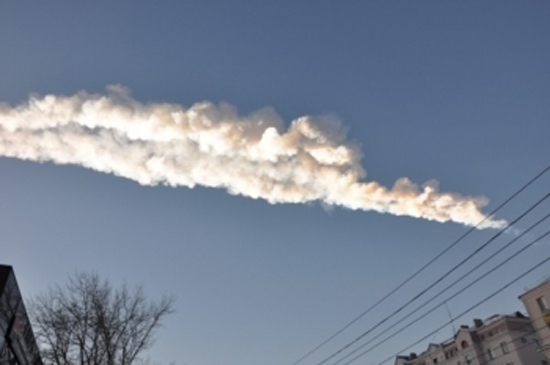Fireball Events
Chelyabinsk Meteor of 15 Feb. 2013 - Preliminary results as of Feb 16, 2013

Dr. Peter Brown and the Meteor Physics group at Western have produced a preliminary data analysis of the Chelyabinsk meteor based on the first 24 hours of data analysis.
Based on the infrasound period of the tratospheric waveforms averaged at the closest six stations and using the yield relation for multi-station fireball detections found in;
Ens T. A., Brown P., Edwards W. N., and Silber E. 2012. Infrasound production by bolides: A global statistical study. Journal of Atmospheric and Solar-Terrestrial Physics 80: 208–229.
a mean acoustic period of 32.5 second for the airwave is found. This corresponds to a nominal yield of 470 kT TNT equivalent and represents a best estimate for the yield of this airburst from a preliminary examination of infrasound records. There remains a potential uncertainty of order a factor of two in this yield value.
Fireball Event Summary
What follows are *initial* information gleaned for multiple instrumental sources recording various aspects of the Feb 15, 2013 airburst over Chelaybinsk, Russia (55.2N, 61.4E) as of Feb 16, 2013
1. Time: The time of the main flare/airburst was 03:20:26 UT on Feb 15, 2013; the fireball began ablation about 30 secs before this time.
2. Based on the long duration of the event and videos, it is clear this was a very shallow entry (certainly less than 20 degrees, maybe more shallow).
3. It is *not* related to 2012 DA14
4. Speed: The fireball entered the atmosphere at 18 km/s
5. Damage: The airblast clearly caused window breakage and light structural damage in downtown Chelaybinsk. The exact overpressure at which window failure occurs tends to be probabilistic and varies by construction design (ANSI S2.20, 1983). Normally some damage begins to occur around 500 Pa of overpressure, widespread window damage is expected to occur up to around ten-20 times this value. As the fireball had a shallow trajectory, the cylindrical blast wave would have propagated directly to the ground and would be expected to be intense. This could be further compounded by any fragmentation, quasi-spherical blasts. My impression is that the key here is that the terminal part of the fireball (probably between 15-20 km altitude) occurred almost directly over Chelaybinsk; this was perhaps the single greatest contributor to the blast damage (short range to the main part of the terminal detonation).

6. Comparators: The Sikhote-Alin fall (Feb 12, 1947) in the former Soviet Union was the equivalent of about 10 kilotons TNT, BUT as an iron impactor much of this energy was deposited at the ground rather than at altitude. The Oct 8, 2009 Indonesia event is the most recent similar event at about 50 kTons, but over the ocean.
7. Size: The pre-impacting asteroid was about 20 meters in diameter and had a mass of the order of ~10000 tonnes.
[Dust trail photo c/o: Russian Emergency Ministry and space.com]



